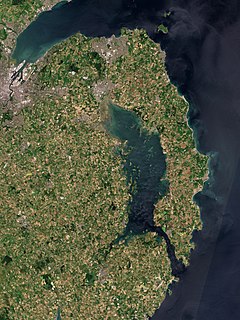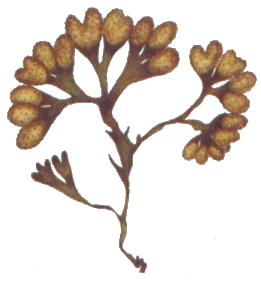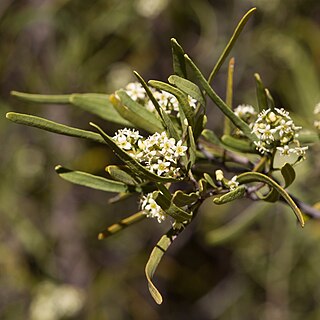
Fucus vesiculosus, known by the common names bladder wrack, black tang, rockweed, bladder fucus, sea oak, cut weed, dyers fucus, red fucus, and rock wrack is a seaweed found on the coasts of the North Sea, the western Baltic Sea, and the Atlantic and Pacific Oceans. It was the original source of iodine, discovered in 1811 and was used extensively to treat goitre, a swelling of the thyroid gland related to iodine deficiency.

Strangford Lough is a large sea loch or inlet in County Down, in the east of Northern Ireland. It is the largest inlet in the British Isles, covering 150 km2 (58 sq mi). The lough is almost totally enclosed by the Ards Peninsula and is linked to the Irish Sea by a long narrow channel at its southeastern edge. The main body of the lough has at least seventy islands along with many islets (pladdies), bays, coves, headlands and mudflats. Strangford Lough was designated as Northern Ireland's first Marine Conservation Zone (MCZ) under the introduction of the Marine Act 2013. It has also been designated a Special Area of Conservation under the EU Habitats Directive, and its abundant wildlife is recognised internationally for its importance.

Sargassum is a genus of brown macroalgae (seaweed) in the order Fucales. Numerous species are distributed throughout the temperate and tropical oceans of the world, where they generally inhabit shallow water and coral reefs, and the genus is widely known for its planktonic (free-floating) species. Most species within the class Phaeophyceae are predominantly cold-water organisms that benefit from nutrients upwelling, but the genus Sargassum appears to be an exception. Any number of the normally benthic species may take on a planktonic, often pelagic existence after being removed from reefs during rough weather; however, two species have become holopelagic—reproducing vegetatively and never attaching to the seafloor during their lifecycles. The Atlantic Ocean's Sargasso Sea was named after the algae, as it hosts a large amount of Sargassum.

Fucus is a genus of brown algae found in the intertidal zones of rocky seashores almost throughout the world.

Adenanthos is a genus of Australian native shrubs in the flowering plant family Proteaceae. Variable in habit and leaf shape, it is the only genus in the family where solitary flowers are the norm. It was discovered in 1791, and formally published by Jacques Labillardière in 1805. The type species is Adenanthos cuneatus, and 33 species are recognised. The genus is placed in subfamily Proteoideae, and is held to be most closely related to several South African genera.

Fucus spiralis is a species of seaweed, a brown alga, living on the littoral shore of the Atlantic coasts of Europe and North America. It has the common names of spiral wrack and flat wrack.

Wrack is part of the common names of several species of seaweed in the family Fucaceae. It may also refer more generally to any seaweeds or seagrasses that wash up on beaches and may accumulate in the wrack zone.

Callitris columellaris is a species of coniferous tree in the family Cupressaceae, native to most of Australia. Common names include White Cypress-pine, Murray River Cypress-pine, and Northern Cypress-pine. Callitris columellaris has become naturalised in Hawaii and in southern Florida.

Lambertia is a genus of flowering plants, belonging to the family Proteaceae. It is endemic to Australia. The genus was named in 1798 by Sir James Edward Smith in honour of English botanist Aylmer Bourke Lambert.
Adenanthos eyrei is a species of shrub in the family Proteaceae. Restricted to a single cliff-top dune system on the remote south coast of Western Australia, it is listed as rare and endangered. It was discovered by E. Charles Nelson in 1973, and formally described and named in 1978.
Perophora japonica is a species of colonial sea squirt in the genus Perophora, native to the North Indo-Pacific. It has spread to several other parts of the world including the south coast of Britain, France, the Netherlands and the west coast of the United States.
Hakea tuberculata is a shrub in the family Proteaceae, endemic to several isolated areas along the coast in the Peel, South West, Great Southern and Goldfields-Esperance regions of Western Australia.

Hakea lissocarpha, commonly known as honey bush or the duck and drake bush, is a shrub of the genus Hakea native to a large area in the Mid West, Wheatbelt, Peel, South West, Great Southern and Goldfields-Esperance regions of Western Australia.
Sargassum horneri is a species of brown macroalgae that is common along the coast of Japan and Korea. It is an annual algae which has a varying fertile season along the coast. In Wakasa Bay it began to grow in early autumn through winter, becoming matured in Spring, when the sea water temperature was 11.6–15.2 °C (53–59 °F) in average. Also called "devil weed", this species has invaded the Eastern Pacific, beginning in Baja California and advancing north along the California coastline.

Caulerpa sertularioides, also known as green feather algae, is a species of seaweed in the Caulerpaceae family found in warm water environments.

Kyphosus bigibbus, the brown chub, grey drummer, darkfin drummer, insular rudderfish, grey chub, grey sea chub, southern drummer or topsail drummer is a species of marine ray-finned fish, a sea chub from the family Kyphosidae. It is a herbivorous species which is found in subtropical and tropical seas worldwide.

Geijera linearifolia, commonly known as oilbush or sheepbush, is a species of shrub in the family Rutaceae and is endemic to southern Australia. It has simple linear to oblong leaves, much-branched cymes of greenish-white flowers, and fruit containing a shiny black seed.

Senecio linearifolius, commonly known as fireweed groundsel,is a species of flowering plant in the family Asteraceae. It is a small shrub with variable leaves, numerous heads of yellow flowers and grows in Tasmania, New South Wales and Victoria.













